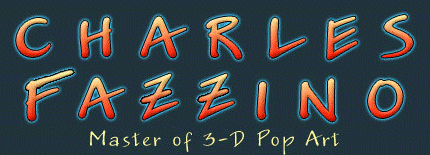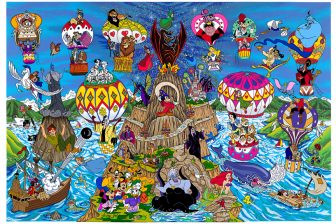I just returned from a fantastic tour in Japan! I’m exhausted from signing but thrilled that i got to meet so many people while i was there.
This morning, I read with great interest a blog posting today on ARTicles, “The blog of the National Arts Journalism Program.” It made me think…I wanted to write a blog posting in response, so I turned to my assistant Julie for some words. She’s a little better writer than I am…so here’s what we came up with together:
Sometimes I blessedly forget that what I do everyday is actually a business. I’m lucky to be able to create my artwork, meet my collectors, travel the world, and enjoy the activity of BEING AN ARTIST every day of my life. And then I come across articles and blog postings like this one by Peter Plagens on the ARTicles blog and it snaps me back to reality. He critiques an underground DVD made by legendary Time Magazine Art Critic Robert Hughes titled “The Mona Lisa Curse.” To oversimplify Hughes’s argument (and I urge you to read the entire blog for yourself), he believes that the touring of the Mona Lisa at the MOMA in 1963 was the beginning of the downfall of the art industry…the descent into what he considers to be the over-excesses, decadence, and greed that some feel dominate the contemporary art world. The Mona Lisa exhibit brought the appreciate of art down to the masses and the masses appreciate the “appearance” of talent and the “popularity” of talent more than the talent itself, giving rise to today’s somewhat exploitative contemporary art world. Mind you, this isn’t MY argument….just Hughes’s.
While to some extent I agree with Hughes…many contemporary artists are “made” by their sponsors…wealthy clients and gallery owners who, for some reason, decide to back them and elevate their reputations among their own social circles. However, this really isn’t anything new, as Plagens points out. Societal power players have always used the arts as a way to elevate their own status. Kings, Pharoahs, the Church, etc…all patronized the arts, their blessings essentially “making the careers” of artists throughout history.
So, when you look at today’s anointed contemporary art royalty (ie. Damien Hirst and his diamond-encrusted skulls and Jeff Koons with his flowered dogs and such), try to evaluate them for the artists they are. If you like sharks in formaldehyde for their artistic merit, then that’s art to you. But, it’s sometimes difficult to separate them from their own showmanship. And remember that they are part of a long historical line of “sponsored” artists who transcended their own art to become more popular icon than artist.
So, back to the “business” end of art. Hughes tries to make the claim that the trends in contemporary art are new – the spending of millions of dollars on Warhol, Pollock, and Hirst work at auction. It’s not new at all. Art has always been a business, with the owners of expensive artwork viewed in the same vein as owners of expensive cars and expensive jewelry and expensive homes. Art is often a status symbol and in the end, I think THAT is what Hughes is really criticizing.
That’s where I agree with him. I am an artist. I love what I do and I am lucky to be able to do it for a living. There are so many talented artists in the world who never get that opportunity. But it’s my hope that people enjoy my art based on its merits…that they get pure enjoyment out of it. That it touches an emotional place and allows people to see themselves in my work. To me, THAT’s what contemporary art and pop art is all about. So, while I’m often considered to be a part of that contemporary art BUSINESS, I’m really just an artist…trying to express the world around me in the best way that I know how. And I hope you enjoy it!





